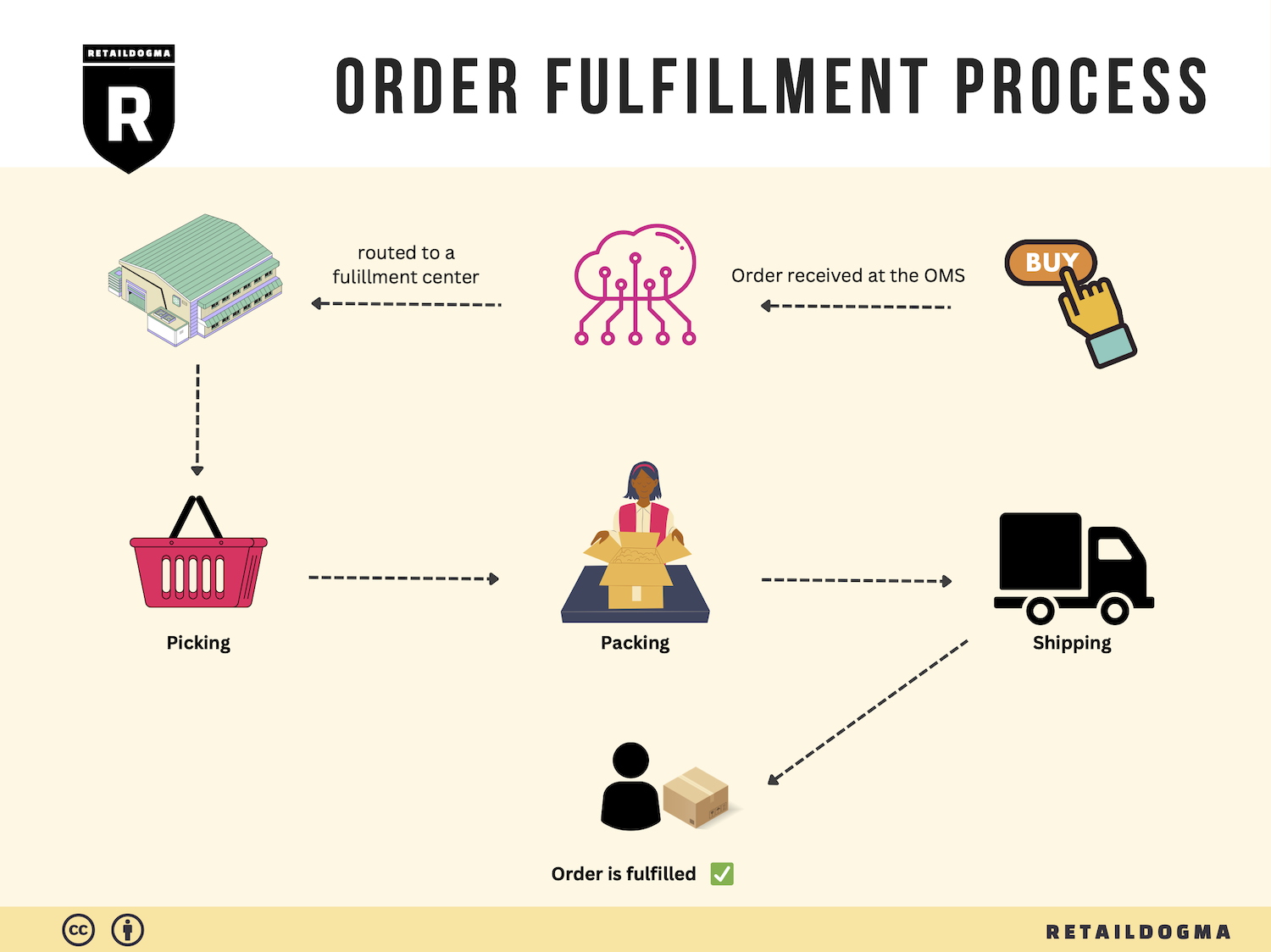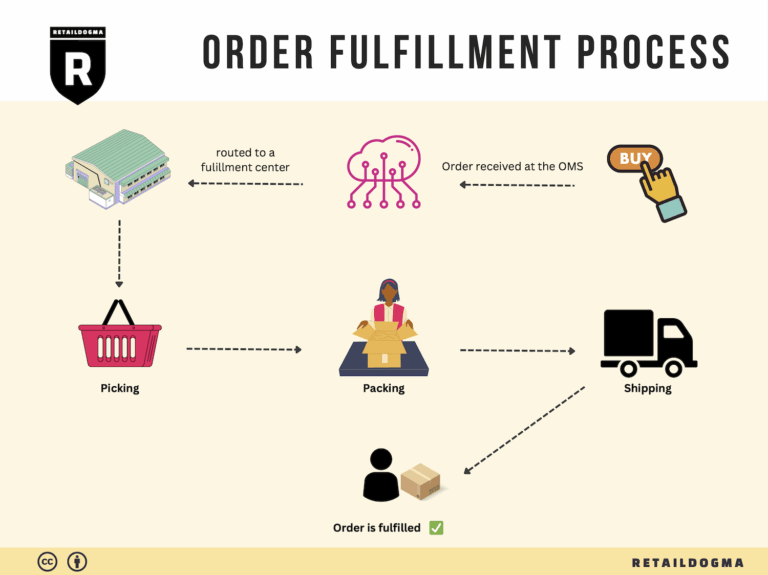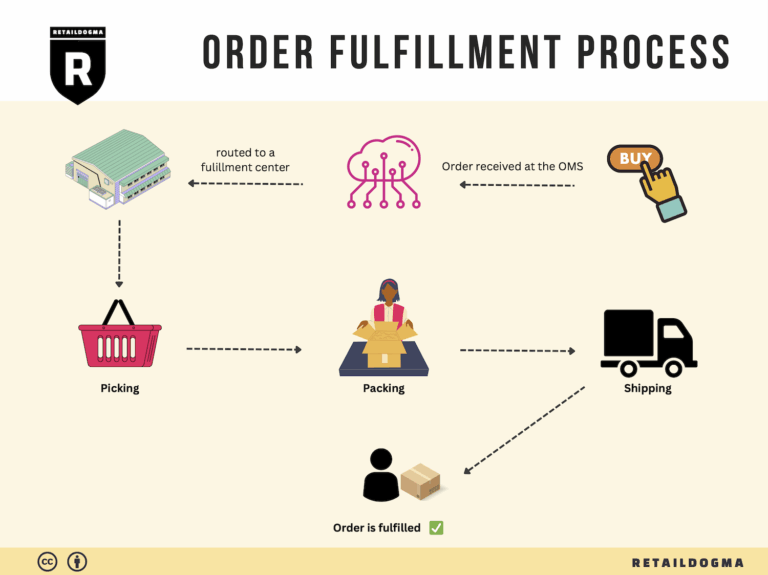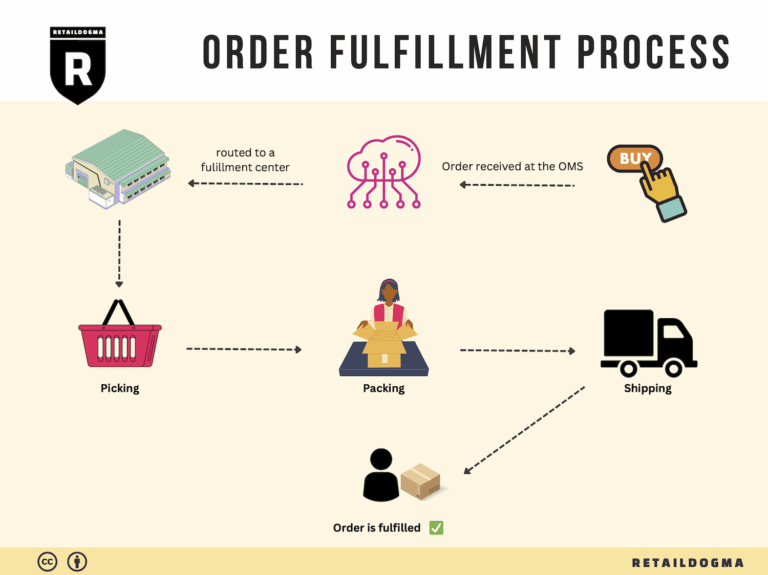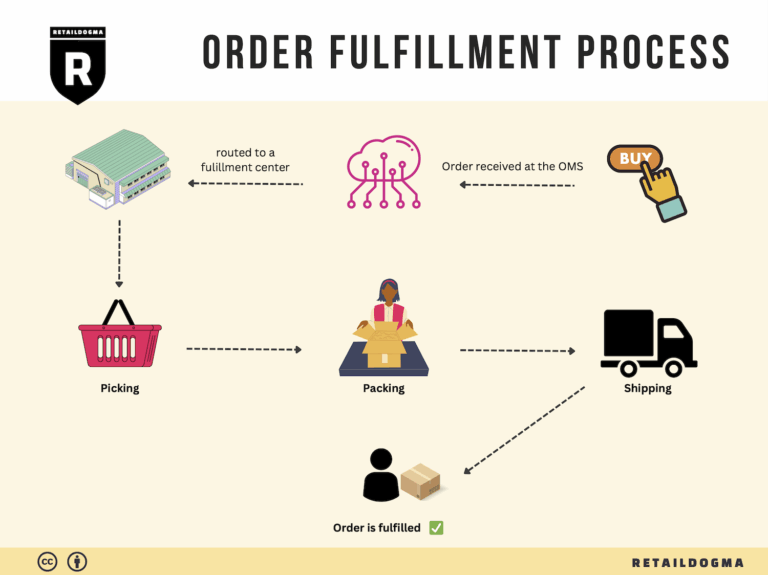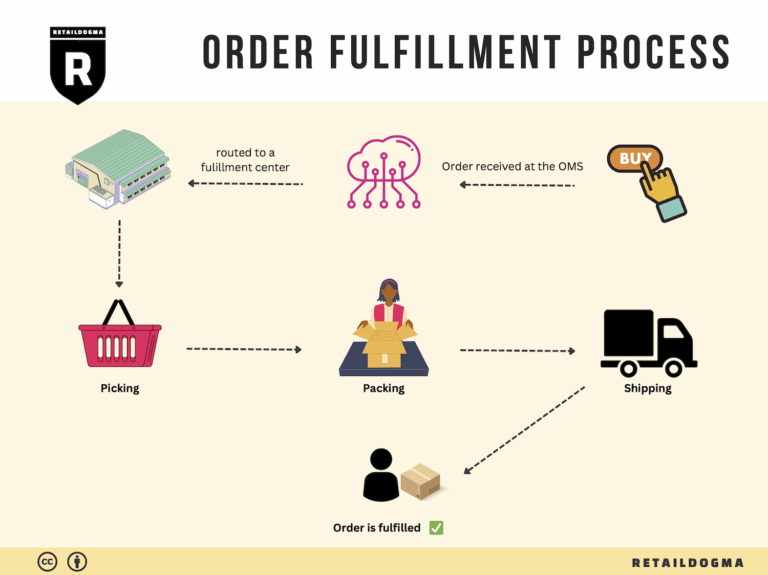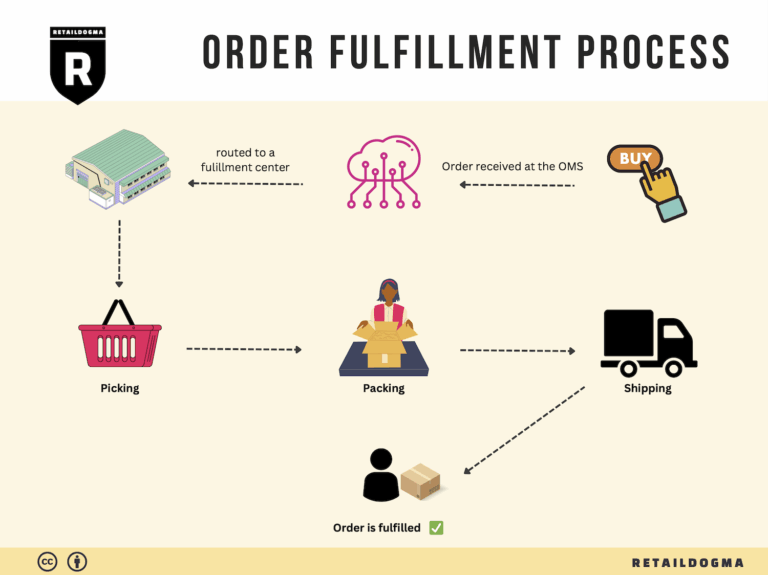What Is A Fulfillment Center? A Complete Guide (2025)
What is E-commerce Fulfillment? An Introduction for Growing Businesses
Understanding E-commerce Fulfillment: A Key to Scaling Your Business
As a growing e-commerce business owner, you might often feel overwhelmed with the logistics of packing and shipping orders. The excitement of making sales can quickly turn into a logistical nightmare if you don’t have a solid fulfillment strategy in place. Fulfillment is simply the process of getting your product from your warehouse or storage location to your customer’s doorstep. This critical component of your business can significantly impact customer satisfaction, operational efficiency, and ultimately, your bottom line.
In this guide, we will explore the various models of e-commerce fulfillment that can help streamline your operations. You’ll learn about Third-Party Logistics (3PL) providers, which can handle warehousing, packing, and shipping on your behalf, allowing you to focus on growing your business. We’ll also delve into Fulfillment by Amazon (FBA), a service that enables you to leverage Amazon’s extensive logistics network to fulfill orders directly from their fulfillment centers.
Moreover, we will outline the core services that fulfillment partners typically offer, such as inventory management, order processing, returns handling, and shipping options. Understanding these services will help you assess what you truly need for your business model and customer base.
Choosing the right fulfillment partner is crucial. We will provide practical tips on what to look for in a provider, including reliability, scalability, technology integration, and customer service. The right partner can make all the difference, especially as your business scales.
Finally, we will discuss pricing structures associated with different fulfillment models. Understanding these costs will enable you to make informed financial decisions and select the option that aligns with your budget and growth strategy.
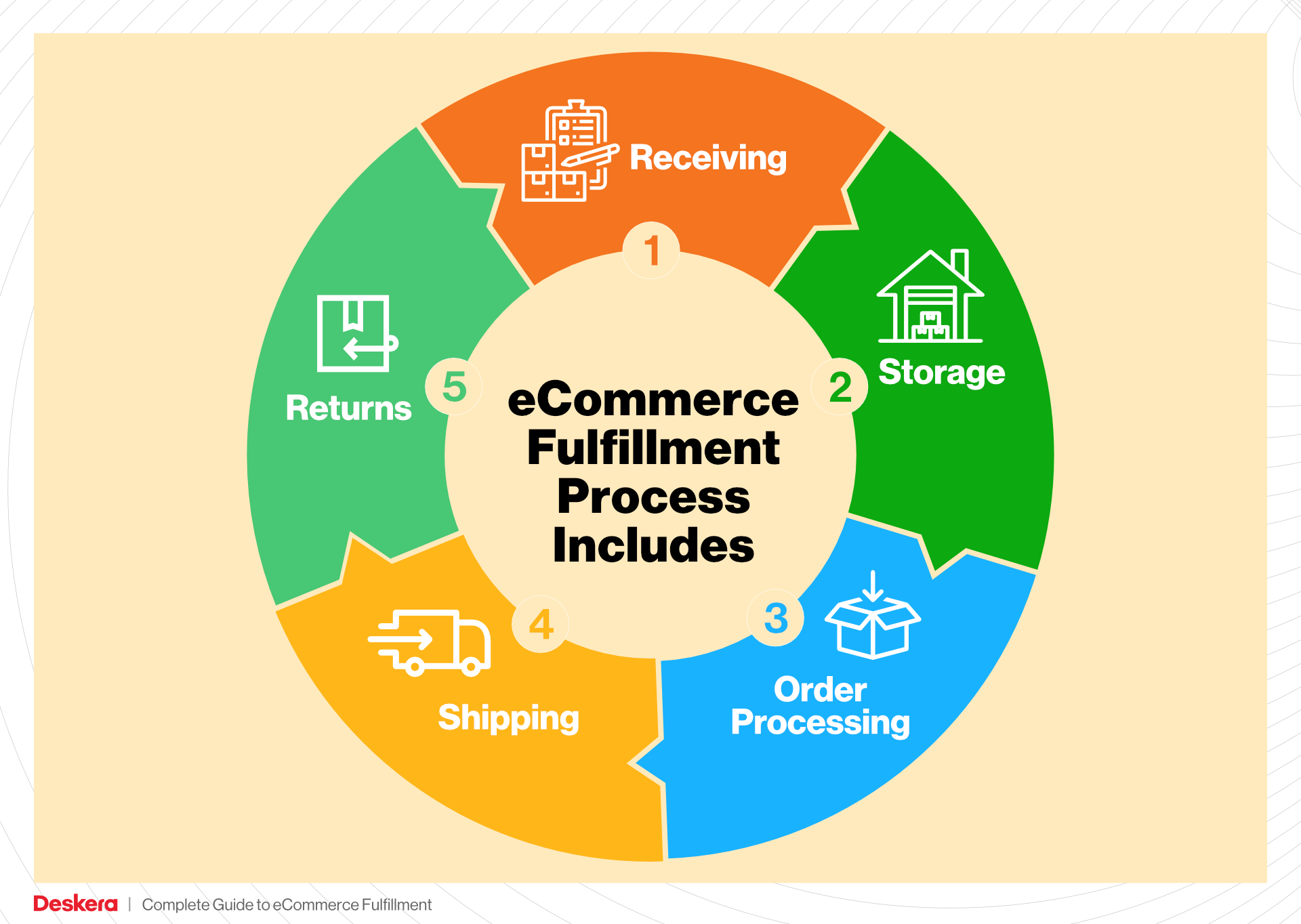
The goal of this guide is to empower you to make smart, strategic decisions about your logistics. By demystifying the fulfillment process and offering clear insights into various options, we aim to equip you with the knowledge you need to enhance your operational efficiency and elevate your customer experience. Whether you’re just starting or looking to scale, effective fulfillment can be the backbone of your e-commerce success.
What You’ll Learn In This Guide
- What is E-commerce Fulfillment? An Introduction for Growing Businesses
- The Order Fulfillment Process: From ‘Buy’ Button to Customer’s Door
- Comparing Fulfillment Models: In-House vs. 3PL vs. Dropshipping
- A Deep Dive into Amazon FBA: Pros, Cons, and Who It’s For
- Core Services Offered by Fulfillment Centers
- How to Choose a Fulfillment Partner: A 6-Point Checklist
- Understanding Fulfillment Pricing: A Breakdown of Common Fees
- Frequently Asked Questions (FAQs) about Fulfillment
- Conclusion: Is Outsourcing Fulfillment the Right Move for Your Business?
- Important Disclaimer
The Order Fulfillment Process: From ‘Buy’ Button to Customer’s Door
1. Receiving Inventory
The first step in the order fulfillment process is receiving inventory into your warehouse or fulfillment center. When products arrive from suppliers, they must be verified against purchase orders to ensure accuracy. This involves checking quantities, assessing the condition of items, and ensuring that the correct products have been delivered.
Importance: This step is critical because it sets the foundation for all subsequent processes. Accurate receiving reduces the risk of inventory discrepancies, which can lead to order fulfillment errors and customer dissatisfaction.
Key Term: SKU (Stock Keeping Unit) – Each item received is assigned a unique SKU, which aids in tracking and managing inventory efficiently. Proper SKU management is essential for maintaining accurate inventory levels and optimizing reordering processes.
2. Warehouse Storage
Once the inventory is received and verified, it is then stored in the warehouse. This involves organizing products in a way that maximizes space while ensuring easy access for future order picking. This could include shelving units, pallets, or bins, depending on the type of products.
Importance: Efficient storage is vital for reducing picking times and maximizing warehouse space. Properly organized storage systems allow for quicker retrieval of products, which directly impacts the overall speed of the fulfillment process.
Key Term: ABC Analysis – This inventory categorization technique divides products into three categories (A, B, and C) based on their importance and sales volume. Category A items are high-value and fast-moving, while C items are lower in value and slower-moving. This helps prioritize storage locations and picking strategies.

3. Order Picking
Order picking is the process where warehouse staff retrieve items from storage based on customer orders. Pick lists, which detail the items and quantities needed for each order, guide this process. Depending on the size and layout of the warehouse, picking can be done manually or with the assistance of automated systems.
Importance: This step is crucial because it directly affects order accuracy and fulfillment speed. A well-executed picking process reduces the likelihood of errors and ensures that customers receive the correct items in a timely manner.
Key Term: Pick Lists – These lists outline the items that need to be collected for each order. They are essential for ensuring that no items are missed and help streamline the picking process.
4. Order Packing
After picking, the next step is packing the items for shipment. This involves carefully placing the items into shipping boxes, ensuring they are secure and well-protected to prevent damage during transit. Packing also includes labeling packages with shipping information and including any necessary documentation, such as invoices or return labels.
Importance: Proper packing is essential for maintaining product integrity and enhancing the customer experience. A well-packed order reduces the risk of returns due to damage and helps build customer trust and satisfaction.
Key Term: Packaging Materials – The selection of appropriate packaging materials (e.g., bubble wrap, packing peanuts, and sturdy boxes) is critical for protecting products during shipping. Using the right materials can also reduce shipping costs and improve sustainability efforts.
5. Shipping & Delivery
The final step in the order fulfillment process is shipping the packed orders to the customer. This involves coordinating with shipping carriers to transport packages efficiently. Tracking information is usually generated at this stage, allowing customers to monitor their shipments in real-time.
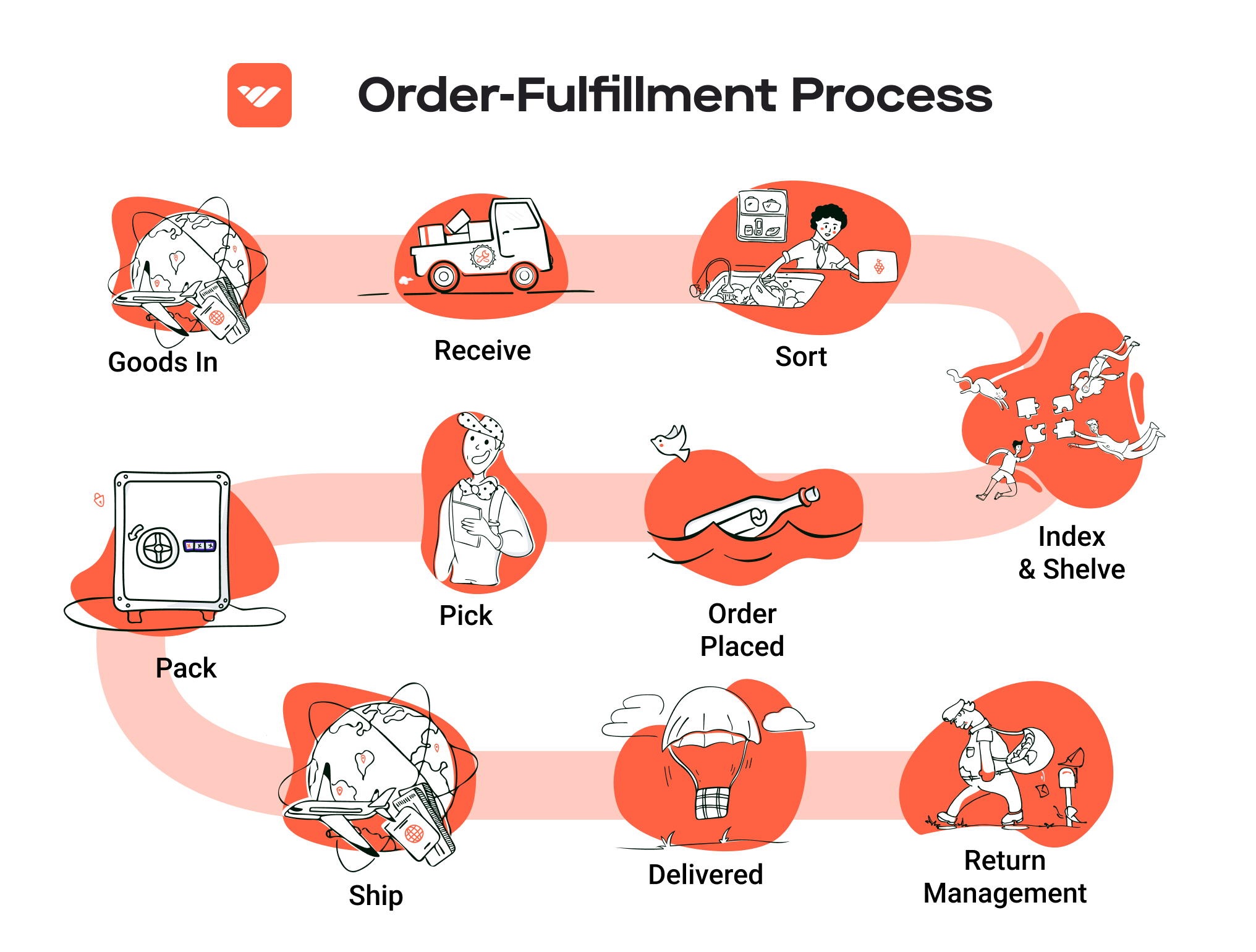
Importance: Timely delivery is a key factor in customer satisfaction. Efficient shipping processes enhance the overall customer experience, encouraging repeat business and positive reviews.
Key Term: Last-Mile Delivery – This term refers to the final leg of the shipping process, where packages are delivered from a transportation hub to the customer’s doorstep. Efficient last-mile delivery strategies are essential for reducing delivery times and improving customer satisfaction.
By understanding and optimizing each step of the order fulfillment process, e-commerce businesses can scale effectively while enhancing customer satisfaction. Each phase is interconnected, and improvements in one area can lead to significant efficiencies throughout the entire supply chain.
Comparing Fulfillment Models: In-House vs. 3PL vs. Dropshipping
Fulfillment Model Comparison
| Model | Who Handles Inventory | Best For (Business Stage) | Key Advantage | Key Disadvantage |
|---|---|---|---|---|
| In-House Fulfillment | The business itself | Established businesses | Complete control over operations | High overhead costs and complexity |
| Third-Party Logistics (3PL) | A third-party provider | Scaling businesses | Cost-effective and scalable | Less control over inventory |
| Dropshipping | Suppliers | Startups and small businesses | Low overhead and no inventory risk | Lower profit margins and longer shipping times |
In-House Fulfillment
In-house fulfillment refers to the process where a business manages its own inventory and handles all aspects of order fulfillment internally. This model is most suitable for established businesses that have the capital to invest in warehousing, staffing, and technology. The primary advantage of in-house fulfillment is the complete control it offers over inventory management, shipping processes, and customer service. Businesses can customize their packaging and shipping methods, which can enhance brand identity and customer satisfaction. However, this model comes with significant overhead costs, including warehouse rent, employee salaries, and operational expenses. Moreover, as order volumes fluctuate, maintaining an efficient operation can become increasingly complex and challenging, potentially leading to bottlenecks and increased lead times.
Third-Party Logistics (3PL)
Third-party logistics (3PL) involves outsourcing the inventory management and fulfillment processes to specialized logistics providers. This model is particularly advantageous for businesses that are scaling and need to rapidly adapt to changing market demands without incurring high fixed costs. 3PL providers offer a range of services including warehousing, order processing, and shipping, which can significantly reduce the burden on the business. The key advantage of using 3PL is the cost-effectiveness and flexibility it provides; businesses can scale their logistics operations up or down based on demand without the need for large investments in infrastructure. However, the main disadvantage is the reduced control over inventory and fulfillment processes, which can lead to challenges in maintaining quality service and ensuring that customer expectations are met.
Dropshipping
Dropshipping is a fulfillment model where the retailer does not keep the products it sells in stock. Instead, when a retailer sells a product, it purchases the item from a third party—usually a wholesaler or manufacturer—who then ships it directly to the customer. This model is ideal for startups and small businesses that want to minimize upfront investment and avoid the complexities of inventory management. The primary advantage of dropshipping is its low overhead; retailers do not have to invest in warehousing or inventory. Additionally, it allows for a wide variety of products to be offered without the risk of unsold stock. However, dropshipping also comes with its challenges, such as lower profit margins due to reliance on suppliers for pricing, and potential delays in shipping times which can affect customer satisfaction. Furthermore, retailers have limited control over product quality and fulfillment speed, which can impact their brand reputation.
Conclusion
Choosing the right fulfillment model is critical for e-commerce success and depends on various factors including business size, growth stage, and operational capacity. In-house fulfillment offers control but at a high cost, while 3PL provides flexibility and scalability. Dropshipping minimizes risk but can lead to challenges in profitability and customer satisfaction. E-commerce businesses must evaluate their unique circumstances and long-term goals to select the fulfillment model that best aligns with their strategic objectives.
A Deep Dive into Amazon FBA: Pros, Cons, and Who It’s For
What is Fulfillment by Amazon (FBA)?
Fulfillment by Amazon (FBA) is a service offered by Amazon that allows e-commerce sellers to store their products in Amazon’s fulfillment centers. This service is designed to simplify the logistics of selling products online, enabling sellers to reach Amazon’s vast customer base while Amazon handles storage, packing, shipping, and customer service. When a customer orders a product, Amazon picks, packs, and ships the item on behalf of the seller. Additionally, FBA products are eligible for Amazon Prime, which can significantly enhance visibility and sales.
How FBA Works
-
Setting Up an Account: To start using FBA, sellers must create an Amazon Seller account. Once registered, they can enroll in the FBA program.
-
Product Listing: Sellers list their products on Amazon, indicating which ones will be fulfilled through FBA. They can choose to use existing listings or create new ones.
-
Shipping Inventory: Sellers ship their products to Amazon’s fulfillment centers. Amazon provides guidelines on how to package and label the items correctly to ensure smooth processing.
-
Storage: Once the products arrive at the fulfillment center, they are stored until sold. Amazon manages the inventory, ensuring that it is organized and ready for fulfillment.
-
Order Fulfillment: When a customer places an order, Amazon picks the product from the inventory, packs it, and ships it directly to the customer. Amazon also handles returns and customer service inquiries.
-
Payment: After an order is fulfilled, the seller receives payment, minus Amazon’s fees for the FBA service.
Pros of Fulfillment by Amazon
1. Prime Eligibility
FBA products are automatically eligible for Amazon Prime, which can attract a large segment of customers who prefer fast and free shipping. This increased visibility can lead to higher sales volumes.
2. Customer Trust
Amazon is a well-established brand known for its reliability. By using FBA, sellers can leverage Amazon’s reputation, which can enhance customer trust and lead to better conversion rates.
3. Multi-Channel Fulfillment
FBA allows sellers to fulfill orders from other sales channels (such as eBay or their own websites) using Amazon’s infrastructure. This flexibility can simplify logistics and reduce the overhead associated with managing multiple fulfillment processes.
4. Time Savings
By outsourcing storage, packing, and shipping, sellers can focus more on other crucial aspects of their business, such as marketing and product development. This can lead to greater efficiency and scalability.
5. Scalability
FBA can accommodate growth. As sales increase, sellers can easily send more inventory to Amazon without needing to invest in additional warehousing or fulfillment staff.
Cons of Fulfillment by Amazon
1. High Fees
FBA comes with various fees, including storage fees for inventory and fulfillment fees based on the size and weight of the products. These costs can add up and significantly impact profit margins, especially for low-cost items.
2. Strict Inventory Rules
Sellers must adhere to Amazon’s strict inventory management policies, including guidelines on labeling, packaging, and storage. Failure to comply can result in additional fees or penalties.
3. Commingling Risks
FBA uses a commingling system where inventory from multiple sellers is stored together. While this can streamline operations, it also poses risks if a seller’s product is damaged or if there are counterfeit issues, as it may be difficult to trace responsibility back to the original seller.
4. Limited Control
Sellers have limited control over the fulfillment process. This includes aspects like packaging and shipping times, which can affect customer satisfaction if not managed well by Amazon.
5. Dependency on Amazon
Using FBA can create a dependency on Amazon’s platform. Changes in Amazon’s policies or algorithms can directly impact a seller’s business, making it crucial for sellers to stay informed and adaptable.
Who is FBA Best For?
Fulfillment by Amazon is particularly advantageous for:
-
Small to Medium-Sized Businesses: Businesses looking to scale without the overhead of managing their own fulfillment centers can benefit significantly from FBA. It allows them to focus on growth while Amazon handles logistics.
-
Sellers with High Volume Sales: Those who anticipate high sales volumes can take advantage of the efficiencies provided by FBA, allowing them to manage increased demand without additional resources.
-
New Sellers: For entrepreneurs just starting, FBA offers a straightforward way to enter the e-commerce space without needing to invest heavily in logistics and warehousing.
-
Brands Seeking National Reach: Sellers looking to reach a wider audience across the U.S. can leverage Amazon’s extensive distribution network to ensure timely deliveries.
In conclusion, FBA presents a valuable opportunity for e-commerce sellers to streamline their logistics while gaining access to Amazon’s vast customer base. However, it is essential to weigh the pros and cons carefully to determine if it aligns with your business strategy and goals. By understanding how FBA works and who it benefits, sellers can make informed decisions about leveraging this powerful fulfillment option.
Core Services Offered by Fulfillment Centers
Inventory Management & Warehousing
Fulfillment centers serve as critical hubs for inventory management and warehousing, providing e-commerce businesses with the necessary infrastructure to store their products securely. This service includes the receipt, storage, and organization of inventory in a manner that optimizes accessibility and space utilization.
Benefits:
1. Space Optimization: By utilizing advanced storage solutions such as shelving, racking systems, and automated storage and retrieval systems, fulfillment centers maximize storage efficiency. This means businesses can store more products without the need for additional warehouse space.
-
Real-time Inventory Tracking: Fulfillment centers employ sophisticated inventory management systems that allow for real-time tracking of stock levels. This capability helps businesses maintain accurate inventory counts, reducing the risk of stockouts or overstock situations.
-
Cost Efficiency: Outsourcing inventory management to fulfillment centers can significantly reduce overhead costs associated with maintaining a dedicated warehouse. Businesses can save on rent, utilities, and staffing while benefiting from the fulfillment center’s established infrastructure.
-
Scalability: As e-commerce businesses grow, their inventory needs often fluctuate. Fulfillment centers offer scalable solutions, enabling companies to adjust their storage space based on seasonal demand or sales growth without the burden of long-term commitments.
Pick and Pack Services
Pick and pack services are essential for preparing customer orders for shipment. This process involves selecting items from inventory based on customer orders, packing them securely, and preparing them for delivery.
Benefits:
1. Speed and Efficiency: Fulfillment centers employ trained staff and automated systems to streamline the picking and packing process. This efficiency ensures that orders are fulfilled quickly, enhancing customer satisfaction through faster delivery times.
-
Accuracy: Advanced technology such as barcode scanning and order management software minimizes human error during the picking process. This accuracy reduces the likelihood of incorrect shipments, which can lead to costly returns and decreased customer trust.
-
Customization: Many fulfillment centers offer customizable packing solutions, allowing businesses to include promotional materials, personalized notes, or branded packaging. This capability enhances the customer experience and helps build brand loyalty.
-
Labor Flexibility: During peak seasons, fulfillment centers can quickly scale labor up or down to meet demand without the business needing to hire and train additional staff. This flexibility is crucial for managing seasonal fluctuations in order volume.
Kitting and Assembly
Kitting and assembly services involve the process of grouping individual items together into ready-to-ship sets or assembling products before they are shipped. This service is particularly beneficial for businesses that sell complex products or gift sets.
Benefits:
1. Enhanced Product Offering: By offering kitting and assembly, businesses can create bundled products that provide added value to customers. This can increase average order value and attract more buyers looking for convenience.
-
Streamlined Operations: Outsourcing kitting and assembly to fulfillment centers allows businesses to focus on core activities such as marketing and product development. This delegation helps streamline operations and can lead to improved overall efficiency.
-
Quality Control: Fulfillment centers often have quality control measures in place during the kitting and assembly process, ensuring that all products meet quality standards before they are shipped. This can enhance the brand’s reputation and reduce returns.
-
Inventory Management: Kitting services allow businesses to manage their inventory more effectively. Instead of tracking multiple individual components, businesses can manage bundled products, simplifying inventory counts and reducing storage complexity.
Returns Management (Reverse Logistics)
Returns management, or reverse logistics, is a crucial service provided by fulfillment centers that handles product returns from customers. This process includes receiving returned items, inspecting them, restocking them if they are in sellable condition, or managing their disposal if necessary.
Benefits:
1. Customer Satisfaction: Efficient returns management is essential for maintaining customer satisfaction. A streamlined process can ensure that customers receive refunds or exchanges quickly, encouraging repeat business and fostering brand loyalty.
-
Cost Management: Fulfillment centers can help businesses manage the costs associated with returns by implementing efficient inspection and restocking processes. This efficiency can minimize losses from returned inventory and improve overall profitability.
-
Data Insights: Fulfillment centers can provide valuable data on return reasons and patterns. This information can help e-commerce businesses identify product issues or customer dissatisfaction, allowing them to make informed decisions about product improvements or marketing strategies.
-
Space Management: By managing returns efficiently, fulfillment centers can help businesses reclaim valuable warehouse space. This management ensures that returned items are processed quickly and either restocked or disposed of, preventing unnecessary clutter in inventory.
In conclusion, utilizing the core services offered by fulfillment centers allows e-commerce businesses to optimize their operations, enhance customer satisfaction, and focus on growth. By leveraging these services, businesses can scale their logistics effectively while maintaining a competitive edge in the marketplace.
How to Choose a Fulfillment Partner: A 6-Point Checklist
Location & Warehouse Network
Importance:
The geographical location of your fulfillment partner’s warehouses can significantly affect shipping times and costs. Proximity to your customer base reduces transit times, enhances delivery speed, and can lower shipping expenses.
Questions to Ask:
1. Where are your warehouses located, and how does this align with my customer demographics?
2. Do you have a network of warehouses that can facilitate regional distribution?
3. How do you handle shipping to remote or international locations?
Technology & Integrations
Importance:
In today’s digital landscape, robust technology is essential for seamless order processing, inventory management, and real-time tracking. A fulfillment partner with advanced technology can help streamline operations and provide valuable insights into your supply chain.
Questions to Ask:
1. What order management system do you use, and how does it integrate with my e-commerce platform?
2. Can your technology provide real-time inventory updates and order tracking for my customers?
3. What kind of reporting and analytics tools do you offer to help me monitor performance?
Specializations (e.g., cold storage, oversized items)
Importance:
Certain products require specialized handling, whether due to temperature sensitivity or size constraints. Identifying a fulfillment partner with the right capabilities can prevent damage and ensure compliance with regulations.
Questions to Ask:
1. Do you have specialized facilities for handling specific products, such as food items or hazardous materials?
2. What is your experience with oversized or bulky items, and how do you handle storage and shipping for these products?
3. Are there additional costs associated with specialized storage or handling?
Scalability & Capacity
Importance:
As your business grows, your fulfillment partner must be able to scale operations accordingly. A partner with ample capacity can accommodate seasonal spikes in orders without compromising service quality.
Questions to Ask:
1. How do you manage fluctuations in order volume, particularly during peak seasons?
2. Can you provide examples of how you’ve scaled operations for other clients?
3. What is your capacity for expansion, and how quickly can you accommodate additional inventory?
Pricing and Contracts
Importance:
Understanding the pricing structure and contract terms is crucial for maintaining healthy profit margins. Transparency in pricing helps prevent unexpected costs that could erode your bottom line.
Questions to Ask:
1. What is your pricing model (e.g., per order, per item, monthly fees), and what factors influence costs?
2. Are there any hidden fees I should be aware of, such as storage fees or charges for returns?
3. What are the terms of the contract, and is there flexibility for renegotiation as my business needs change?
Customer Support & Reviews
Importance:
Effective customer support is vital for addressing issues promptly and maintaining smooth operations. Additionally, checking reviews and testimonials can provide insight into the partner’s reliability and service quality.
Questions to Ask:
1. What customer support options do you offer (e.g., phone, email, chat), and what are your response times?
2. Can you provide references or case studies from current or past clients?
3. How do you handle service disruptions or operational failures, and what measures are in place to prevent these issues?
Conclusion
Choosing the right fulfillment partner is a critical decision that can impact your e-commerce business’s efficiency, customer satisfaction, and profitability. By using this checklist, you can systematically evaluate potential partners based on key criteria essential for your business’s success. Taking the time to ask the right questions and thoroughly assess your options will help ensure you make an informed decision that aligns with your operational needs and growth objectives.
Understanding Fulfillment Pricing: A Breakdown of Common Fees
Initial Setup Fees
When you partner with a fulfillment center, one of the first costs you may encounter is the initial setup fee. This fee covers the administrative and operational costs associated with onboarding your products into the fulfillment system. Typically, it includes:
- Account setup: Creating your account in the system.
- Integration costs: Establishing connections between your e-commerce platform and the fulfillment center’s software.
- Product onboarding: Inputting your product information, including descriptions, dimensions, and weight into the fulfillment system.
Initial setup fees can vary widely depending on the complexity of your product catalog and the fulfillment center’s pricing structure. Expect these fees to range from a few hundred to several thousand dollars, especially if you have a large inventory or require custom integrations.
Receiving Fees
Once your products arrive at the fulfillment center, you will incur receiving fees. These fees are charged for the labor and resources used to unload, inspect, and store your inventory. The calculation of receiving fees generally depends on:
- Volume of goods: The number of units received can influence the cost. Many fulfillment centers charge per unit or per pallet.
- Condition of goods: If your products require special handling due to fragility or specific storage conditions, additional fees may apply.
Receiving fees can range from $0.20 to $1.00 per item or $10 to $50 per pallet, depending on the fulfillment center’s policies and the nature of the goods.
Storage Fees (per pallet/bin)
Storage fees are recurring costs charged for holding your inventory at the fulfillment center. These fees are typically calculated on a per pallet or per bin basis and can vary by location, especially if the fulfillment center operates in a high-demand area. Key factors influencing storage fees include:
- Duration of storage: Most fulfillment centers charge monthly, so the longer your products remain in storage, the higher the fees.
- Space utilized: The size and weight of your products will determine how many pallets or bins they occupy.
Storage fees can range from $10 to $50 per month per pallet, while bin fees might be lower, typically around $2 to $10 per month, depending on the facility’s pricing model.
Pick & Pack Fees (per item/order)
Pick and pack fees are incurred each time an order is processed. This fee covers the cost of selecting items from storage, packing them for shipment, and preparing them for delivery. Calculation of pick and pack fees generally depends on:
- Number of items per order: Many fulfillment centers charge a base fee for the first item and an additional fee for each subsequent item in the order.
- Packaging requirements: Special packaging or handling requirements can increase the pick and pack fee.
Typical pick and pack fees can range from $1 to $5 per order for the first item and an additional $0.20 to $1.00 for each additional item, depending on the fulfillment center’s policies and your specific needs.
Shipping Fees
Shipping fees are the costs associated with sending your products to customers. These fees can vary based on several factors:
- Shipping method: Ground, express, or same-day delivery options will have different costs.
- Destination: Shipping to remote or international locations often incurs higher fees.
- Weight and dimensions: Heavier or larger packages typically cost more to ship.
Shipping fees can be highly variable, ranging from a few dollars for local shipments to $20 or more for larger packages or expedited services. It’s crucial to understand how a fulfillment center calculates shipping fees to manage costs effectively.
Tips for Getting an Accurate Quote
-
Provide Detailed Information: When requesting quotes, supply detailed information about your products, including dimensions, weight, and any special handling requirements.
-
Understand Pricing Structures: Familiarize yourself with the fulfillment center’s pricing models. Ask for clarity on how each fee is calculated and whether there are any hidden costs.
-
Request a Breakdown: Ask for a detailed breakdown of all potential fees, including initial setup, receiving, storage, pick & pack, and shipping fees. This transparency will help you budget accurately.
-
Consider Volume Discounts: Inquire about discounts for higher volumes of orders, as many fulfillment centers offer tiered pricing based on the number of orders processed.
-
Negotiate Terms: Don’t hesitate to negotiate terms and pricing, especially if you’re committing to a long-term partnership.
By understanding the various fulfillment pricing models and following these tips, you can better manage costs and ensure that your e-commerce operations scale efficiently.
Frequently Asked Questions (FAQs) about Fulfillment
1. What is the hiring process for Amazon fulfillment centers?
The hiring process for Amazon fulfillment centers typically involves submitting an online application, which may not require a resume or extensive interviewing. Candidates may undergo a drug test once hired. Positions are often filled on a rolling basis, and applicants can receive job alerts via text.
2. What types of positions are available at Amazon fulfillment centers?
Amazon offers a variety of positions, including full-time and part-time roles. Common job titles include warehouse associates, picker/packers, and sortation associates. Some facilities may also offer specialized roles related to robotics and logistics management.
3. How much do Amazon fulfillment center employees earn?
Salaries for positions at Amazon fulfillment centers generally start at competitive rates, often around $15 to $19 per hour, depending on the role and location. Full-time employees may also receive comprehensive benefits starting on their first day of employment.
4. What benefits do Amazon fulfillment center employees receive?
Employees at Amazon fulfillment centers can enjoy a range of benefits, including health insurance, retirement plans, paid time off, and employee discounts. Many of these benefits become effective on the first day of employment.
5. What is the difference between a warehouse and a fulfillment center?
A warehouse primarily serves as a storage facility for goods, while a fulfillment center is focused on processing orders and ensuring timely delivery to customers. Fulfillment centers integrate various logistics functions, including inventory management, order picking, packing, and shipping.
6. What is a third-party logistics provider (3PL)?
A third-party logistics provider (3PL) is a service that allows businesses to outsource their logistics operations. This can include warehousing, fulfillment, and shipping. Many e-commerce businesses partner with 3PLs to scale their operations without managing the logistics in-house.
7. How much do fulfillment services cost?
The cost of fulfillment services can vary widely based on several factors, including the volume of orders, storage space required, and additional services needed (like packaging and shipping). Generally, businesses can expect to pay a per-order fee, storage fees, and sometimes additional costs for special handling.
8. What kind of training do employees receive at Amazon fulfillment centers?
Employees at Amazon fulfillment centers undergo comprehensive training that includes safety protocols, operational procedures, and the use of technology such as scanners and industrial equipment. Ongoing training is often provided to help employees stay updated on new systems or processes.
9. Are there opportunities for advancement within Amazon fulfillment centers?
Yes, Amazon fulfillment centers typically offer various career advancement opportunities. Employees can progress to supervisory roles, logistics management, or specialized positions within the operations team, depending on their performance and skills.
10. How can I apply for a job at an Amazon fulfillment center?
To apply for a job at an Amazon fulfillment center, visit the Amazon.jobs website or text specific keywords to receive job alerts. Applications can usually be submitted online, and interested candidates can also sign up for notifications about new job postings.
Conclusion: Is Outsourcing Fulfillment the Right Move for Your Business?
Evaluating the Benefits of Outsourcing Fulfillment
Outsourcing fulfillment can be a transformative decision for e-commerce businesses aiming to scale efficiently. One of the primary benefits is time savings. By partnering with a fulfillment service, you can delegate the complexities of order processing, inventory management, and shipping logistics. This allows you to focus on core business functions, such as product development and marketing, rather than getting bogged down in operational details.
Another significant advantage is scalability. As your sales grow, the demands on your logistics operations will increase. A reliable fulfillment partner can seamlessly adjust to your changing needs, handling everything from seasonal spikes in order volume to expanding product lines without the need for you to invest heavily in additional infrastructure or staffing. This flexibility is critical in today’s fast-paced e-commerce environment.
Additionally, leveraging the expertise of a fulfillment service can enhance your overall operational efficiency. Fulfillment centers often utilize advanced technology and best practices to streamline processes, reduce errors, and improve delivery times. Their experience in logistics can provide insights and efficiencies that may not be available in-house, ultimately leading to a better customer experience.
However, it’s crucial to emphasize that choosing the right fulfillment partner is paramount for your growth. Conduct thorough research and consider factors such as technology capabilities, service levels, and customer support.
Call to Action
To determine if outsourcing fulfillment is the right next step for your business, conduct an audit of your current shipping processes. Identify bottlenecks, inefficiencies, and areas where a fulfillment partner could add value. This strategic assessment will guide you in making an informed decision that aligns with your growth objectives and enhances your operational effectiveness.
Important Disclaimer
⚠️ Important Disclaimer
The information in this guide is for educational purposes. Fulfillment services, pricing, and platform features change frequently. Always conduct your own due diligence and consult with providers directly before making business decisions.
